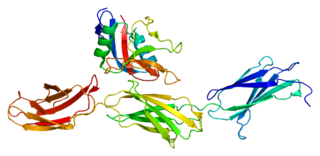
L1, also known as L1CAM, is a transmembrane protein member of the L1 protein family, encoded by the L1CAM gene. This protein, of 200 to 220 kDa, is a neuronal cell adhesion molecule with a strong implication in cell migration, adhesion, neurite outgrowth, myelination and neuronal differentiation. It also plays a key role in treatment-resistant cancers due to its function. It was first identified in 1984 by M. Schachner who found the protein in post-mitotic mice neurons.

Protein tyrosine phosphatases (EC 3.1.3.48, systematic name protein-tyrosine-phosphate phosphohydrolase) are a group of enzymes that remove phosphate groups from phosphorylated tyrosine residues on proteins:
Semaphorins are a class of secreted and membrane proteins that were originally identified as axonal growth cone guidance molecules. They primarily act as short-range inhibitory signals and signal through multimeric receptor complexes. Semaphorins are usually cues to deflect axons from inappropriate regions, especially important in the neural system development. The major class of proteins that act as their receptors are called plexins, with neuropilins as their co-receptors in many cases. The main receptors for semaphorins are plexins, which have established roles in regulating Rho-family GTPases. Recent work shows that plexins can also influence R-Ras, which, in turn, can regulate integrins. Such regulation is probably a common feature of semaphorin signalling and contributes substantially to our understanding of semaphorin biology.

Protein tyrosine kinase 2 beta is an enzyme that in humans is encoded by the PTK2B gene.

Receptor-type tyrosine-protein phosphatase alpha is an enzyme that in humans is encoded by the PTPRA gene.

Receptor-type tyrosine-protein phosphatase F is an enzyme that, in humans, is encoded by the PTPRF gene.

Receptor-type tyrosine-protein phosphatase zeta also known as phosphacan is an enzyme that in humans is encoded by the PTPRZ1 gene.

Contactin-2 is a protein that in humans is encoded by the CNTN2 gene.

Neurofascin is a protein that in humans is encoded by the NFASC gene.

Receptor-type tyrosine-protein phosphatase mu is an enzyme that in humans is encoded by the PTPRM gene.

Neuronal cell adhesion molecule is a protein that in humans is encoded by the NRCAM gene.

Receptor-type tyrosine-protein phosphatase PCP-2, is an enzyme that in humans is encoded by the PTPRU gene.

Neurocan core protein is a protein that in humans is encoded by the NCAN gene.

Receptor-type tyrosine-protein phosphatase kappa is an enzyme that in humans is encoded by the PTPRK gene. PTPRK is also known as PTPkappa and PTPκ.

Receptor-type tyrosine-protein phosphatase T is an enzyme that in humans is encoded by the PTPRT gene.

Contactin-4 is a protein that in humans is encoded by the CNTN4 gene.

Tyrosine-protein phosphatase non-receptor type 14 is an enzyme that in humans is encoded by the PTPN14 gene.

Tenascin-R is a protein that in humans is encoded by the TNR gene.

Contactin 6 is a protein in humans that is encoded by the CNTN6 gene.

CASPR also known as Contactin associated protein 1, Paranodin and CASPR1 is a protein that in humans is encoded by the CNTNAP1 gene. CASPR is a part of the neurexin family of proteins, hence its another name "Neurexin IV". CASPR is a membrane protein found in the neuronal membrane in the paranodal section of the axon[[]] in myelinated neurons, between the Nodes of Ranvier containing Na+ channels, and juxtaparanode, which contains K+ channels. During myelination, caspr associates with contactin in a cis complex, though its precise role in myelination is not yet understood.






















